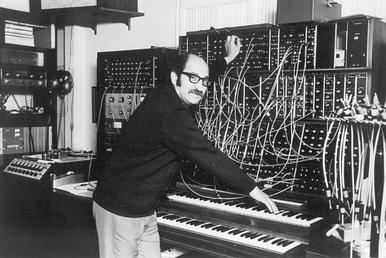Mort Garson - (Mother Earth's) Plantasia
Discover Mort Garson's "Plantasia," the pioneering 1976 electronic album created for plants using Moog synthesizers, now a rediscovered cult classic in electronic music.

Plant yourself down for a bit and soak up one of the more curious albums to cycle its way through popular culture throughout the decades. There's a very good chance you've never heard of Mort Garson or his incredible Plantasia. And there's a pretty good reason why.
Released in 1976, Plantasia was a free giveaway for people who purchased a houseplant from the Mother Earth store in Los Angeles. To make things more unlikely that many people would ever actually listen to it, it described itself as "warm earth music for plants…and the people that love them". Popular culture has run with the "made for plants" angle and there's little harm in entertaining it, if only to set the stage for the unlikely popularity that this obscure and forgotten record would have first with vinyl collectors and then with... the modern world?
Dusty fingers and green thumbs
As the sampling era switched on a generation of crate diggers, Plantasia found itself emerging from the dusty depths of milk crates and thrift shops as much due to its unique artwork as anything else. Behind the children's scribbles of a happy couple hugging an equally happy houseplant, lies a seriously cool history and an early example of a Moog synthesiser featuring prominently on an instrumental album of largely electronic music.
Mort Garson was Canadian musician that had moved to New York to study at the Juilliard School of Music. He graduated to become a popular session pianist in the 1960s, working in the studio with the likes of Doris Day, Cliff Richards and Bill Withers. But it was an encounter with Bob Moog showcasing his new synthesizer concept at the Audio Engineering Society’s West Coast convention in 1967 that changed everything for Garson. Keeping in mind that by 1970 there were only estimated to be some mere handfuls of musicians owning and using the early Moog modular systems, being well before the era of Pete Bellotte and Giorgio Moroder popularising the instrument on Domma Summer's timeless "I Feel Love". Garson was early to say the least. Which makes his relative obscurity ever the more perplexing.
Unlike the wave of Disco and other dance genres that would draw their inspiration from Kraftwerk's earnest incorporation of synthesizers as pop music machinery, Plantasia is perhaps more the logical successor of the groundbreaking (and Grammy Award winning) Switched On Bach. This was an album by the incredibly talented and forward thinking Wendy Carlos, using a Moog synthesiser as the source instrument for a series of Bach compositions, more to prove the instrument capable of "serious music" as an obsession with dour (if brilliant) Germans and overly busy Baroque excursions.
A jumble (and jungle) of influence
These more Classical influences can be heard in the regal swing on tracks like the timelessly titled "Concerto for Philodendron & Pothos". Or understood at a glance across the tracklisting with titles like "Rhapsody in Green" and "Symphony for a Spiderplant". But this is where Plantasia becomes such a fascinating artefact. It's not just the "Classical music with synthesisers" schtick that would get a little out of control as a marketing ploy well into the early 1980s. It's also not just the endearingly twee "Swingin' Spathiphyllums", which sounds like the Casio version of Frank Sinatra meets "The Girl from Ipanema" in a Psilocybin hallucination. There are, and this is important to note, absoutely incredible tracks on this album.
The standout for me has always been the namesake "Plantasia", with an unabashedly bold brass synth lead melody, some beautifully meanindering arpeggios, and a genuinely surpringly masterful mix-down. If I didn't know this was recorded in 1976 I would assume it was the more recent product of a nostlagic composoer with a passion for modular synths and concept albums.
A case in point is the middle section of "Symphony for a Spider Plant". A refrain drops into a jaunty melodic progresson composed of two seperate synthesizer lines panned hard left and right (curiously swapping sides on how one might play this on a real piano), with a very contemporary sounding bass tone emerging to pedal right down the centre channel, building into some trippy delays of a spacey areggio tone (that repeats across the album), and then departs with the jaunty (perhaps even pretentious) melodic fingerwork. Bizarre, brilliant, both rooted in the art and music of the era but somehow so far in the future in concept and studio quality.
Remember that this is an album given away with the purchase of houseplants. From a visionary Canadian composer somehow many years ahead of his contemporaries (that nobody knew of). It doesn't make sense and is all the better for it.

Impact and legacy
As you might expect, the quirky nature of the album, the unique and clear synthesiser sounds, the groovey basslines and catchy little melodies have made Plantasia a popular source of samples. Especially given the hard panning of the sound in the stereo field, a technique of the era that crate diggers adore for the relative isolation of individual sounds. But the overall aesthetic of this obscure masterpiece is one that has had an outsized impact on producers both indirectly and directly. And the addictive quality of the compositions are only aided by the inevitable question... "who the hell is this?".
If a friend put "Ode to an African Violet" on, and told you that it was a new track from the French downtempo pop masters Air, it wouldn't seem out of place. It's a playful mix of nostlagia and melancholy, with gently catchy topline meldoies, the chatter of what sounds like an early Roland (then Rhythm Ace) drum machine sat deep in the mix, the track is another standout on the record. Regardless of your feelings about African violets.
It's not all magic however, as tracks like "You Don't Have to Walk a Begonia" give clues to how close this whole thing could have just fallen into the reject bins of any number of "Hammond Organ plays the hits" novelty records that were churned out in the 1970s as unobtrusive background noise. Thankfully the Psilocybin kicks back in on "A Mellow Mood for Maidenhair", and we exit with what sounds like a love letter to the Roland Space Echo, the closing track "Music to Soothe the Savage Snake Plant". Which dare I say is music to sooth this savage planet of ours.
Whether it's in 1976, our current situation in 2022, or in some far future times ahead. May we embrace our inner monsteras and not our inner monsters. Or something like that... I've had maybe a little too many "plants" here for now, man.
Essential links and references
- You can grab a copy of the Sacred Bones Records reissue of Mother Earth's Plantasia. At the time of writing there's a pre-order for a special limited run as part of the label's 15th anniversary.
- Mort Garson's Wikipedia page is a great read for more context on his relationship with Bob Moog and his exploits as a composer.
- Stream Plantasia on Tidal for the best quality, Spotify because you probably already have it, and Bandcamp where you may want to buy a digital copy. Your plants will love you for it.
- Vice have run a lovely profile on Mort Garson's underappreciated career. Check it and remember it's okay to overappreciate to bring it all into balance.


